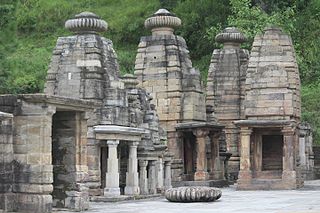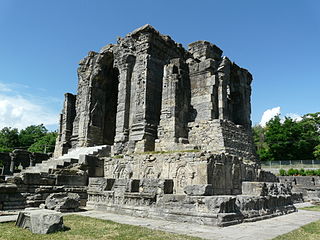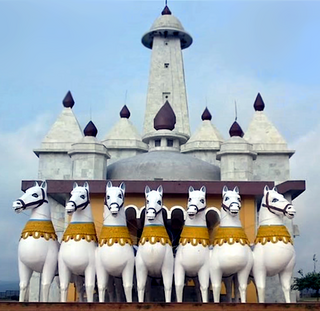 W
WThe Biranchi Narayan Sun Temple, also known as the Abode of Viranchinarayana or the Wooden Konark, is a Hindu Temple located in the town of Buguda in Ganjam, Odisha. It is the second Surya temple constructed in Odisha, after the famous Konark Sun Temple.
 W
WThe Gop temple is a Sun temple located at Zinavari village in Jamjodhpur Taluka of Jamnagar district, Gujarat, India. The Hindu temple is dated to the 6th century and is one of the earliest surviving stone temples in Gujarat. The original temple had a square plan, a mandapa and covered circumambulation passage which are lost, and a pyramidal masonry roof which is ruined but whose partial remains have survived. The temple has a height of 23 feet (7.0 m) which includes a small tower. The roof of the tower is decorated with arch-like gavaksha window shapes below an amalaka cogged wheel-shaped crown.
 W
WKatarmal is a remote village located in Kumaon Division, in Almora District, Uttarakhand, India.
 W
WKonark Sun Temple is a 13th-century CE Sun temple at Konark about 35 kilometres (22 mi) northeast from Puri on the coastline of Odisha, India. The temple is attributed to king Narasimhadeva I of the Eastern Ganga Dynasty about 1250 CE.
 W
WThe Martand Sun Temple is a Hindu temple dedicated to Surya and built during the 8th century CE. Martand is another Sanskrit synonym for Surya. Now in ruins, the temple is located five miles from Anantnag in the Indian union territory of Jammu and Kashmir. The temple was destroyed on the orders of Sultan Sikandar Butshikan, as part of his efforts to forcibly convert Kashmiri people to Islam.
 W
WThe Sun Temple of Multan, also known as the Aditya Sun Temple, was an ancient Hindu sun temple, that was the base of a sun worshipping sect dedicated to Surya, the Hindu Sun God, that is located in the city of Multan, modern day Pakistan.
 W
WNavlakha Temple at Ghumli, Gujarat, India, is a 12th Century temple built by Jethwa rulers.
 W
WThe Sun Temple is a Hindu temple dedicated to the solar deity Surya located at Modhera village of Mehsana district, Gujarat, India. It is situated on the bank of the river Pushpavati. It was built after 1026-27 CE during the reign of Bhima I of the Chaulukya dynasty. No worship is offered now and is protected monument maintained by Archaeological Survey of India. The temple complex has three components: Gudhamandapa, the shrine hall; Sabhamandapa, the assembly hall and Kunda, the reservoir. The halls have intricately carved exterior and pillars. The reservoir has steps to reach the bottom and numerous small shrines.
 W
WThe Surya Temple or Surya Mandir, located near Bundu, is a Hindu temple complex dedicated to the solar deity, Surya.
 W
WSuryanar Kovil is a Hindu temple dedicated to the deity Hindu Sun-God, located in Suryanar Kovil, a village near the South Indian town of Kumbakonam Thanjavur District in Tamil Nadu, India. The presiding deity is Suriyanar, the Sun and his consorts Ushadevi and Pratyusha Devi. The temple also has separate shrines for the other eight planetary deities. The temple is considered one of the nine Navagraha temples in Tamil Nadu. The temple is one of the few historic temples dedicated to Sun god and is also the only temple in Tamil Nadu which has shrines for all the planetary deities.
 W
WArasavalli Sun Temple is a temple for Lord Surya at Arasavalli in Andhra Pradesh, India. It is situated in Arasavalli Village at a distance of 1 km east of Srikakulam Town. It is believed that the temple was originally built by the 7th century CE king Devendra Varma, a ruler of Kalinga. However, the present structure is largely a result of 18th century renovations. The temple is still being visited today and is one of the most popular tourist attractions in the town. This temple is considered as one of the oldest sun temples in India.
 W
WSuryanarayana Temple is a Sun temple situated in Gollala Mamidada village of Pedapudi Mandal, East Godavari district of Andhra Pradesh, India. The temple was founded in 1920 by Sri Kovvuri Basivi Reddy, the zamindar of Gollala Mamidada, near the Antharvahini river amongst 16 acres of grass fields and coconut palms. The temple is 20 km (12 mi) from Kakinada and 58 km (36 mi) away from Rajahmundry. Some of the rites and festivals performed include Archanas, Abhishekams, Ratha Saptami, and Ekadasi.